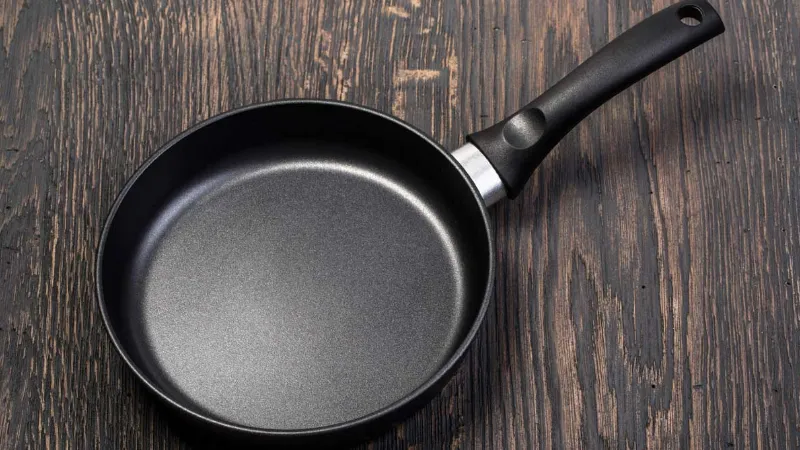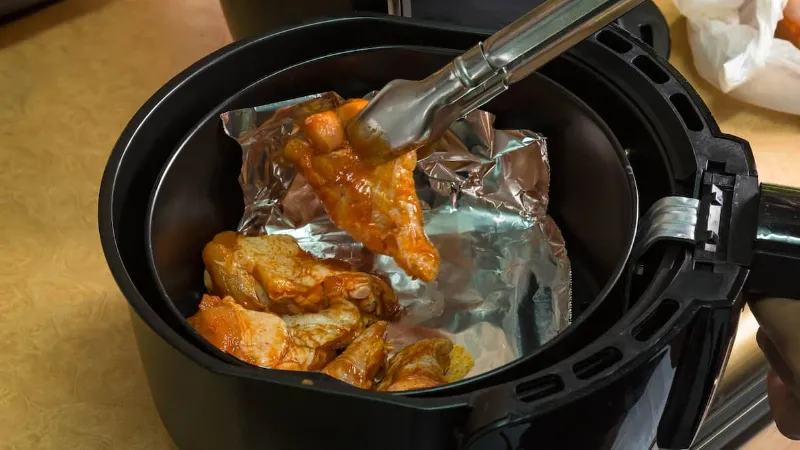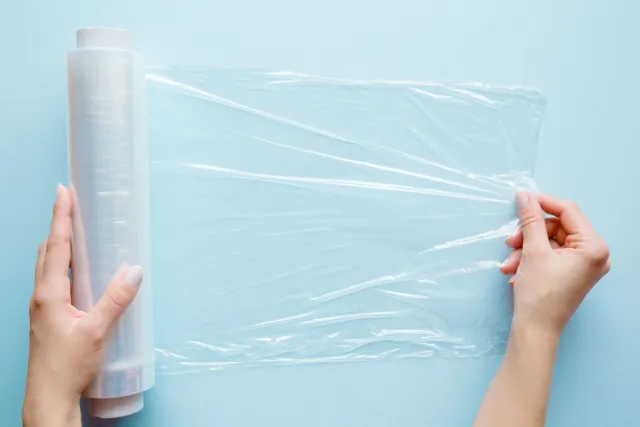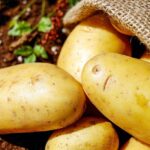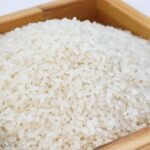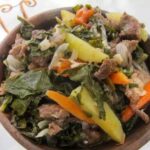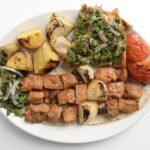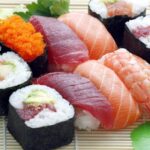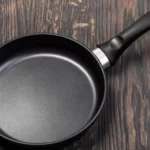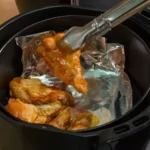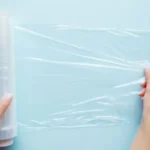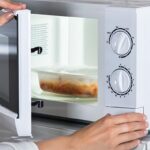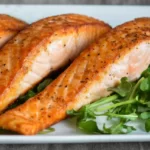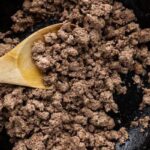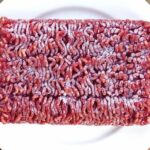Can Non-Stick Pans Go in the Oven? See Answer
Read on to find out if all non-stick pans are oven-safe, the highest temperatures that they can withstand, the precautions to take, and what type of pan is best used in the oven!
Can non-stick cookware be used in the oven? It is best to check the packaging or the manufacturer’s website for the recommended temperature before placing your non-stick pan in the oven because the majority of non-stick pans are oven-safe up to specific temperatures.
Keep reading.
Table of Contents
Are All Non-Stick Pans Oven-Safe?
Many people are apprehensive about using non-stick pans in the oven for fear of damaging the pans’ coating.
While these fears aren’t completely baseless since non-stick pans do get damaged when exposed to high heat, most non-stick pans can go in the oven up to certain temperatures.
It is best to look at the packaging or the manufacturer’s website for the instructions to determine whether your specific non-stick pan is oven safe or not.
On the bottom of the pans, there is frequently a mark indicating whether they are oven-safe or not.
However, with non-stick cookware, you must always find the maximum temperature it can withstand.
Considering that some previously manufactured Teflon-coated pans have the potential to emit toxic fumes at high heat, this is especially crucial.
You must make sure that all parts of the pan are oven-safe and not just the bottom part. The handles and lids must be heat-resistant and there should be no rubber or plastic seals on the pan.
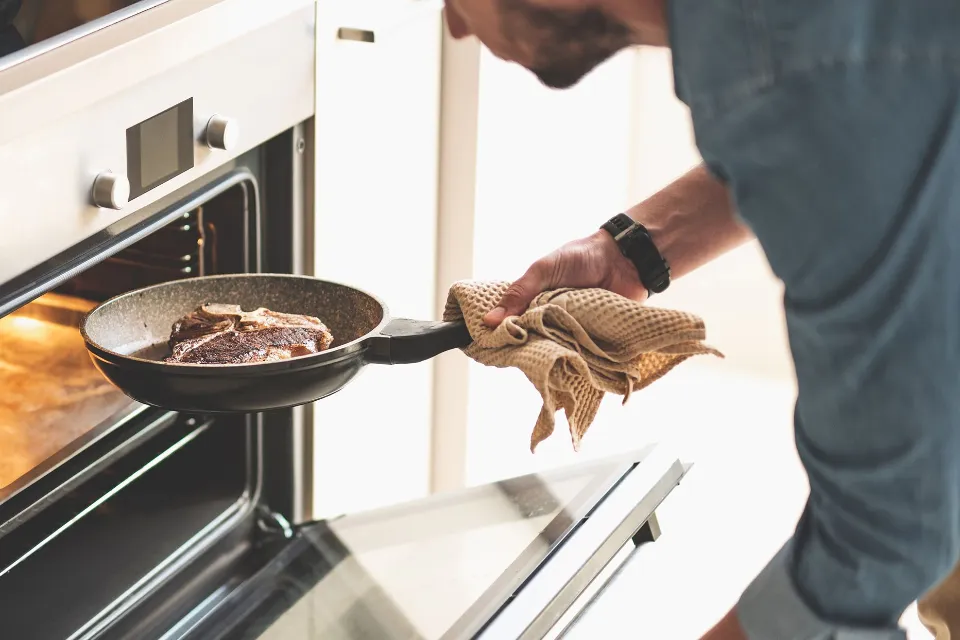
Factors to Consider
Brands
Calphalon
With a heat capacity of 450°F, Calphalon non-stick pans are suitable for use in ovens. Avoid sudden temperature changes to maintain the pan’s quality.
The pan also heats up quickly, making it perfect for cooking in the oven. Also, its PFOA-free non-stick surface is smooth and can be wiped clean with a paper towel.
Cuisinart
The glass pan lids and oven-proof Cuisinart non-stick pans can withstand temperatures of up to 350°F. However, you can only use Cuisinart pans inside the oven for 20 minutes.
Use potholders when removing the pan because all parts, including the handles, are hot and rubber or plastic handles melt in heat.
Farberware
Oven-safe non-stick cookware and skillets from Farberware. It is made of aluminum, which heats up quickly and uniformly to avoid burned spots.
Easy-to-grasp plastic knobs are on the shatterproof glass lid that is oven proof. Additionally, it can withstand heat up to 350° F.
Circulon
Cookware made of hard-anodized aluminum is known as Circulon non-stick. It can withstand high heat up to 400 degrees Fahrenheit and is oven safe.
The oven and stovetop are both safe places to use these sturdy stainless steel pans.
Kitchenaid
For long-lasting food release, Kitchenaid pots and pans are finished with triple-layer non-stick properties. With handles made of silicone that withstand temperatures of up to 400 degrees Fahrenheit, it can be used in the oven.
The stainless handles and silicone grips can be separated, and the heat tolerance is up to 500 degrees Fahrenheit. Glass lids on it are also oven-safe up to 350 degrees Fahrenheit.
Coatings
There are two kinds of non-stick coatings: Teflon and Ceramic. These two pans are both oven-safe and have a temperature range of up to 500°F.
PTFE, a synthetic water-repellent coating, is used on Teflon non-stick pans while silica-gel is used on ceramic non-stick pans. PFOA is not present in Teflon-coated pans, so there are no health risks.
Teflon pans are more durable than ceramic non-stick pans, in the opinion of consumers, because they keep food from sticking and last longer.
Maximum Temperature Capacity
Non-stick pans typically withstand heat up to 500°F in the oven.
Checking the user’s manual is essential before using a non-stick pan in the oven because the temperature capacity of some of these parts, such as handles and lids, can vary.
“A hug you can taste when you eat something hot out of the oven.”
– Regina Brett, American Author, and News Journal Columnist
Higher temperatures have an impact on the non-stick coating and may result in discoloration, which may reduce its efficacy.
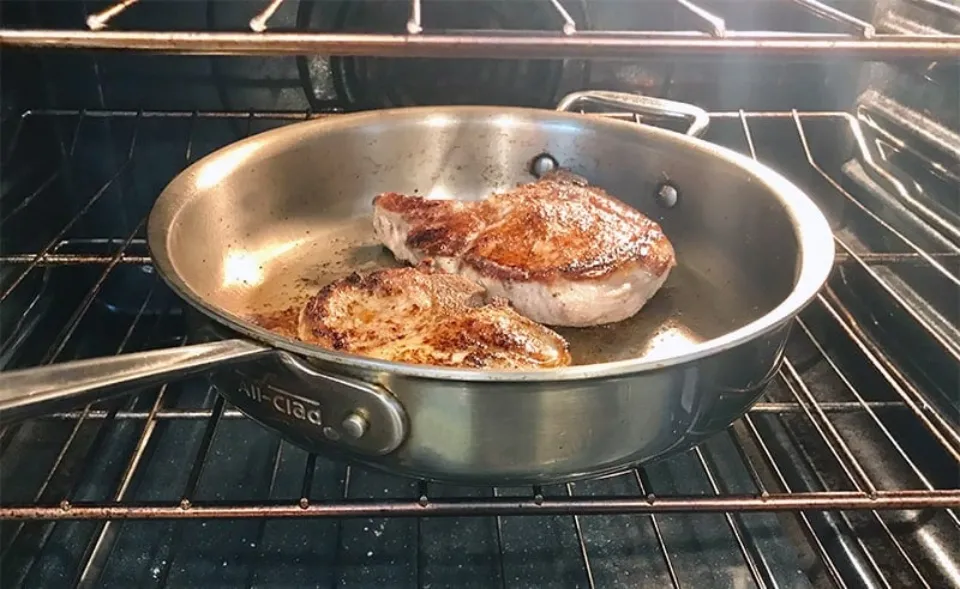
What Temperatures Can Non-Stick Pans Withstand in the Oven?
Teflon (polytetrafluoroethylene) and ceramic coatings are the two types of non-stick pans available. Both are only partially heat-resistant and cannot be used at extremely high temperatures.
It is crucial to understand these safe temperature ranges before using these pans in the oven so as to avoid damaging them or causing them to release hazardous chemicals.
When heated over 570°F, Teflon-coated pans can emit toxic fumes that may give you flu-like symptoms if you’re exposed to them over an extended period of time.
Pans made of Teflon or ceramic may become stained and lose their ability to stay non-stick.
In the event that the advised temperature range, i.e., 500°F, most non-stick ceramic pans are oven-safe.
In order to avoid toxic fumes when using Teflon pans, we advise replacing any that were produced prior to 2013.
Teflon non-stick pans made after 2013 are PFOA-free and are generally safe to use in the oven.
Almost all non-stick pans, regardless of the kind of coating they have, should never be heated above the suggested temperature and should never be used in the broiler.
Read about
How to Tell If a Non-Stick Pan is Oven-Safe?
Oven Safe Handles
Stainless Steel
Stainless handles can be used in the oven without any issues. They need little maintenance and are strong. The majority of pan lids, however, are not stainless.
When handling pans with stainless handles, always use oven mitts as they get hot too.
Iron
Iron handles in non-stick cookware are also oven-safe. Rustic copper skillets with iron handles might be more durable and able to withstand extremely high temperatures.
However, because stainless steel is prone to rust, some cast iron skillet handles require more maintenance than others.
Aluminum
Aluminum handles in non-stick cookware are perfectly fine for oven cooking. It is made to be stronger and heat-resistant.
Silicone
Cast iron pans and other cookware have silicone handles for oven use, but these handles have different heating capacities because they can only withstand 400°F.
When removing a cast iron pan from the oven, modern pans have quick-attaching silicone handles that can be quickly put on.
Manufacturer’s Remark
Look first for the manufacturer’s comments when purchasing non-stick ovenware. The oven-safe symbol is typically positioned at the pan’s base.
A manual may be included with some pans. Before using any cookware in the oven, always read the label and instruction manual.
Avoid accidents by not using something in the oven if the manufacturer has stated that it is not oven-safe.
Are Handles and Lids of Non-Stick Pans Oven-Safe?
Usually, a pan’s handles—especially if they are made of materials like wood or plastic—are what prevent it from going into the oven.
Despite the fact that their insulation qualities make it simple to hold the pan, they can melt at higher oven temperatures. Therefore, whenever using non-stick pans with insulated handles for baking, exercise caution.
Insulating materials such as silicone are much better at withstanding heat and are also oven-safe at temperatures around 330-475°F.
Rubber handles could be a good alternative as well, but after using them in the oven, you might notice some discoloration. This doesn’t affect their functionality, though.
Metal handles made with stainless steel and cast iron are the sturdiest when it comes to withstanding high temperatures of about 500°F in the oven.
Just remember to wear oven mitts when removing pans with metal handles since they can get very hot.
Many modern pans come with detachable handles that can be removed any time you want. This is a clever way to make your non-stick pans immediately oven-safe and is especially helpful if the pan is oven-safe but the handles are not.
Finally, especially if you plan to use the lid in the oven, you might want to inspect the lids that come with the pans.
For non-stick pans with glass lids, you must be extremely careful to not exceed the 400°F temperature limit in the oven or they might shatter due to the extreme heat.
Additionally, the plastic knobs on the majority of pan lids are prone to melting in the oven, which reduces the lids’ ability to withstand heat.
To make the lid oven-safe, make sure to swap out the plastic knobs for stainless steel ones, or, if you can, do without the lid altogether.
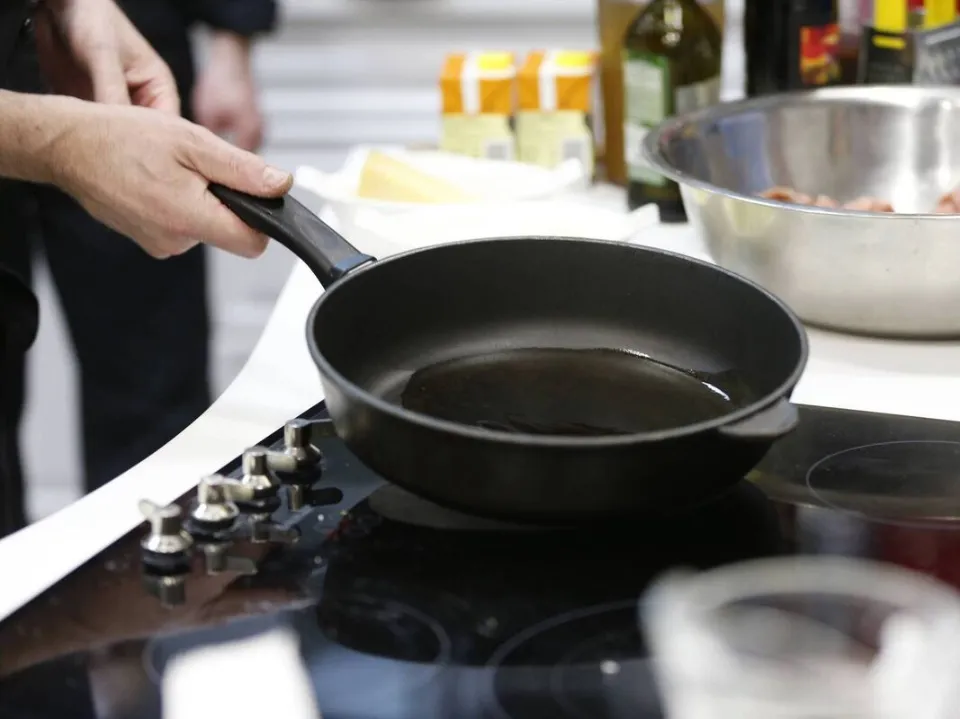
Precautions to Take When Using a Non-Stick Pan in the Oven
Here are a few precautions to take when using non-stick pans, or any other pans, in the oven:
- Never assume that your pan is oven-safe because doing so could cause irreparable damage and possibly cause harmful toxins to release.
- As sudden temperature changes could cause the pan to warp or break, avoid them.
- Always use oven mitts when taking the pan out of the oven since it can become very hot and may burn your hand.
- Never put a non-stick pan under the broiler because the temperature can reach 500°F and the flame could harm the coating.
FAQs
Can Kitchenaid Non-Stick Pans Go in the Oven?
Cooking on the stovetop is the primary application for Kitchenaid’s non-stick pans. However, you can also use them in ovens.
Additionally, these pans typically have oven-safe lids.
The handles on Kitchenaid’s non-stick pans can be silicone or stainless steel, depending on the product line.
Stainless steel handles on cookware can typically withstand temperatures of up to 500°F.
This is enough for most oven-based recipes.
The silicone-handled cookware from Kitchenaid shouldn’t be used in ovens that are hotter than 400°F, though.
When put in an oven, non-stick pans from Kitchenaid get hot.
As a result, whenever handling them, use potholders or oven mitts.
While the non-stick pans from Kitchenaid can be used in a regular oven, a broiler is not one of those appliances.
Additionally, the manufacturer advises against pre-heating, even on low heat, their non-stick cookware.
Before heating the pan, add any necessary oil or ingredients.
Can All-Clad Non-Stick Pans Go in the Oven?
The fact that All-Clad cookware can be used in an oven is one of its best features.
All-Clad non-stick cookware has a premium multilayer Teflon coating that is extremely robust and long-lasting.
Nonstick All-Clad pans can be put in the oven right away. The stovetop and oven can be reached simultaneously.
All-Clad non-stick pans are oven-safe up to 500°F. So you can easily use them for the majority of baking recipes.
However, these pans are not suitable for broiler use.
Additionally, due to the fact that they are not oven-safe, All-Clad nonstick cookware lids should not be used in ovens.
Summary: Can Non-Stick Pans Go in the Oven?
Before using a nonstick pan in the oven, it’s a good idea to check the packaging or temperature recommendations on the manufacturer’s website. This is because the majority of nonstick pans are oven safe at a specific temperature.
If you have any questions, please leave a comment. Thank you for reading.

